2008 BMW 328I SEDAN flat tire
[x] Cancel search: flat tirePage 212 of 274

Wheels and tires
210
Sedan: tire inflation pressures for the 328i
Tire size Pressure specifications in psi/kPa
Traveling speeds
up to a max. of
100mph / 160km/hTraveling speeds
including those exceeding
100 mph / 160 km/h
All pressure specifications in
the table are indicated in
psi/kilopascal with cold tires.
Cold = ambient temperature
without Sports package
205/55 R 16 91 H M+S
225/50 R 16 92 V
225/50 R 16 92 H M+S
225/45 R 17 91 H M+S
225/45 R 17 91 V32/220 36/250 32/220 35/240 32/220 39/270
225/45 R 17 94 V M+S XL 32/220 36/250 32/220 35/240 33/230 41/280
Front: 225/45 R 17 91 V 32/220 - 32/220 - 32/220 -
Rear: 255/40 R 17 94 V - 32/220 - 32/220 - 36/250
Front: 225/40 R 18 88 W 32/220 - 32/220 - 32/220 -
Rear: 255/35 R 18 90 W - 36/250 - 35/240 - 39/270
Front: 225/40 R 18 88 Y 32/220 - 32/220 - 32/220 -
Rear: 255/35 R 18 90 Y - 36/250 - 32/220 - 36/250
Front: 225/35 R 19 88 Y XL 35/240 - 32/220 - 35/240 -
Rear: 255/30 R 19 91 Y XL - 41/280 - 35/240 - 41/280
Page 214 of 274
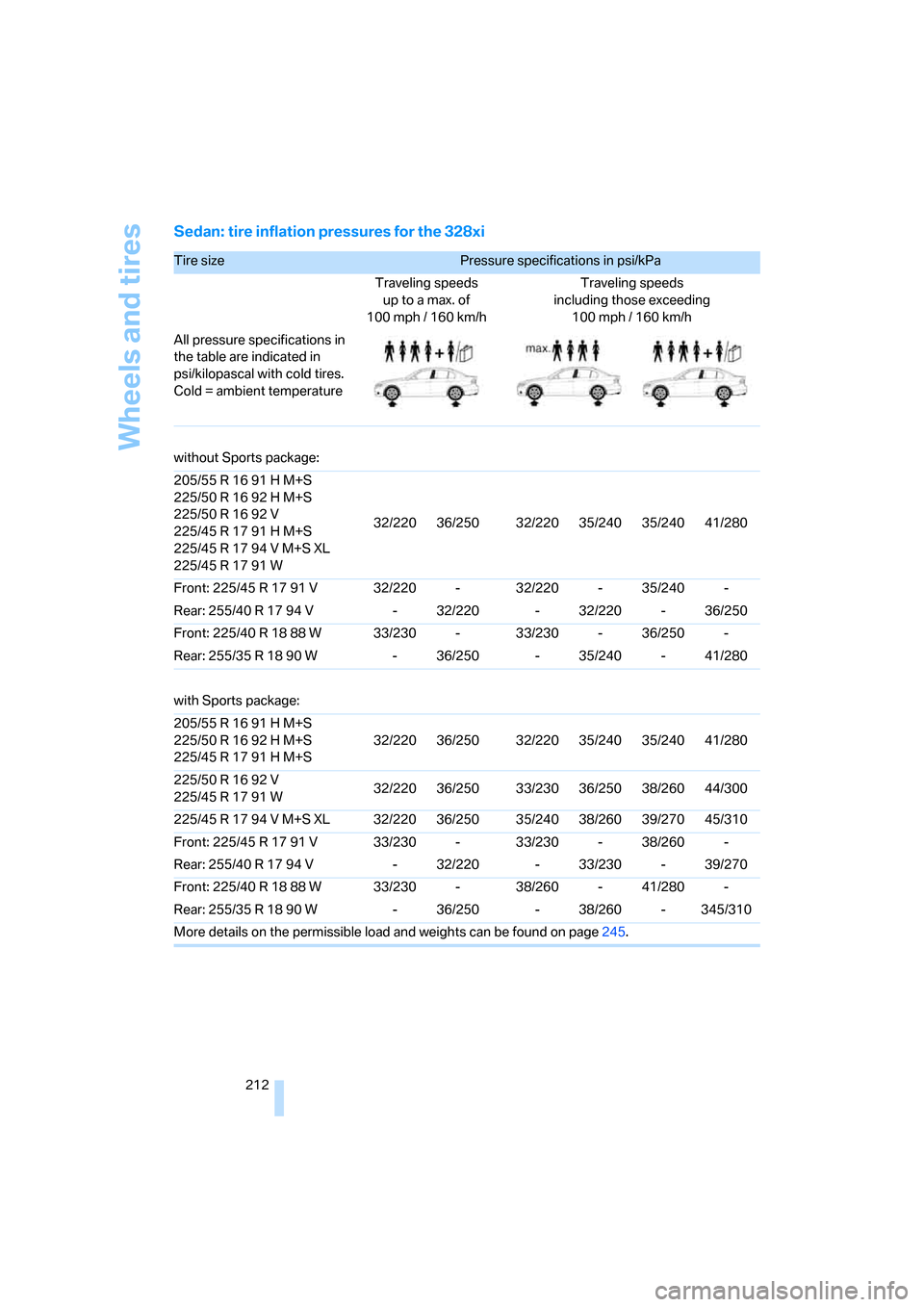
Wheels and tires
212
Sedan: tire inflation pressures for the 328xi
Tire size Pressure specifications in psi/kPa
Traveling speeds
up to a max. of
100mph / 160km/hTraveling speeds
including those exceeding
100 mph / 160 km/h
All pressure specifications in
the table are indicated in
psi/kilopascal with cold tires.
Cold = ambient temperature
without Sports package:
205/55 R 16 91 H M+S
225/50 R 16 92 H M+S
225/50 R 16 92 V
225/45 R 17 91 H M+S
225/45 R 17 94 V M+S XL
225/45 R 17 91 W32/220 36/250 32/220 35/240 35/240 41/280
Front: 225/45 R 17 91 V 32/220 - 32/220 - 35/240 -
Rear: 255/40 R 17 94 V - 32/220 - 32/220 - 36/250
Front: 225/40 R 18 88 W 33/230 - 33/230 - 36/250 -
Rear: 255/35 R 18 90 W - 36/250 - 35/240 - 41/280
with Sports package:
205/55 R 16 91 H M+S
225/50 R 16 92 H M+S
225/45 R 17 91 H M+S32/220 36/250 32/220 35/240 35/240 41/280
225/50 R 16 92 V
225/45 R 17 91 W32/220 36/250 33/230 36/250 38/260 44/300
225/45 R 17 94 V M+S XL 32/220 36/250 35/240 38/260 39/270 45/310
Front: 225/45 R 17 91 V 33/230 - 33/230 - 38/260 -
Rear: 255/40 R 17 94 V - 32/220 - 33/230 - 39/270
Front: 225/40 R 18 88 W 33/230 - 38/260 - 41/280 -
Rear: 255/35 R 18 90 W - 36/250 - 38/260 - 345/310
More details on the permissible load and weights can be found on page245.
Page 215 of 274
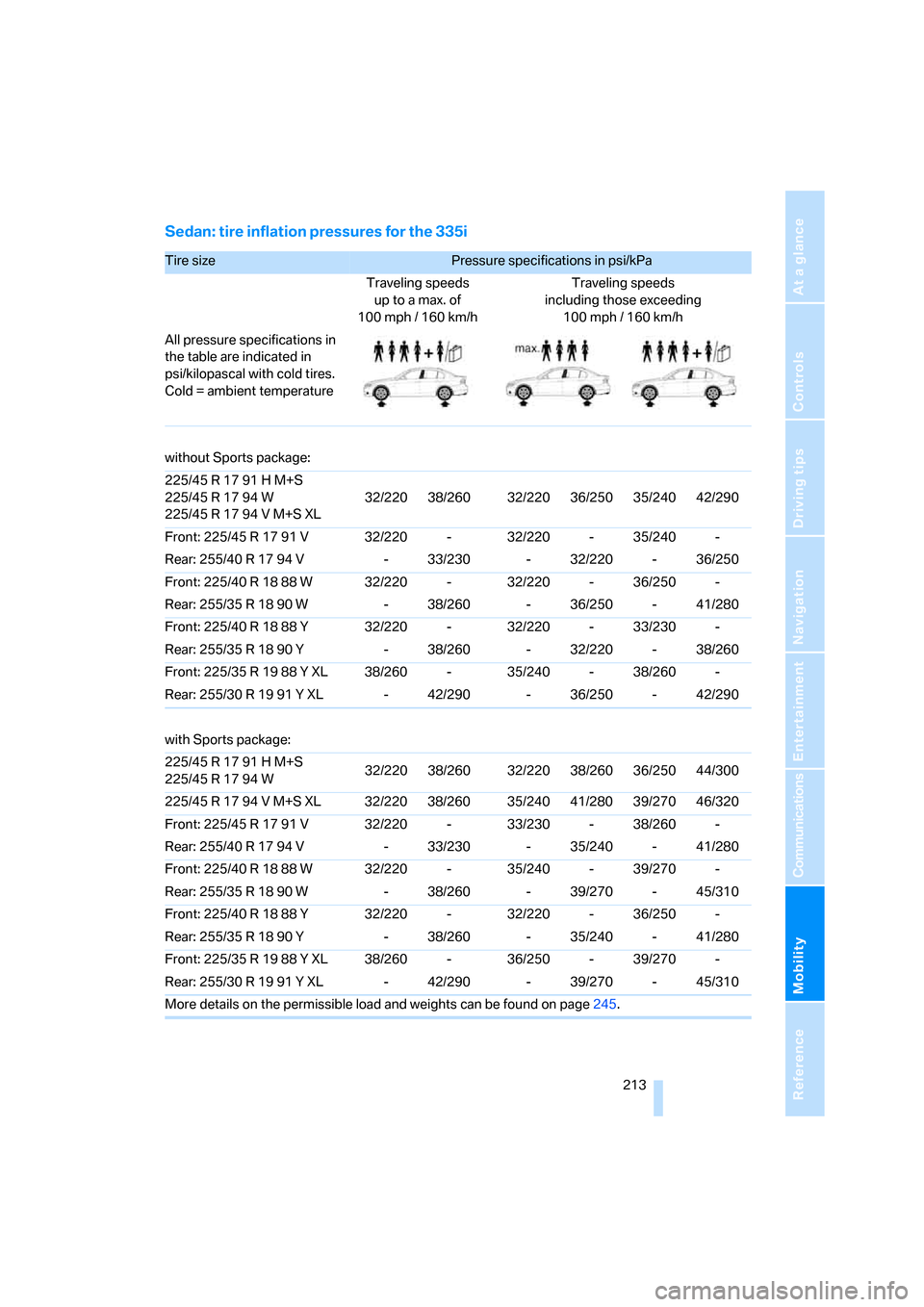
Mobility
213Reference
At a glance
Controls
Driving tips
Communications
Navigation
Entertainment
Sedan: tire inflation pressures for the 335i
Tire size Pressure specifications in psi/kPa
Traveling speeds
up to a max. of
100 mph / 160 km/hTraveling speeds
including those exceeding
100mph / 160km/h
All pressure specifications in
the table are indicated in
psi/kilopascal with cold tires.
Cold = ambient temperature
without Sports package:
225/45 R 17 91 H M+S
225/45 R 17 94 W
225/45 R 17 94 V M+S XL32/220 38/260 32/220 36/250 35/240 42/290
Front: 225/45 R 17 91 V 32/220 - 32/220 - 35/240 -
Rear: 255/40 R 17 94 V - 33/230 - 32/220 - 36/250
Front: 225/40 R 18 88 W 32/220 - 32/220 - 36/250 -
Rear: 255/35 R 18 90 W - 38/260 - 36/250 - 41/280
Front: 225/40 R 18 88 Y 32/220 - 32/220 - 33/230 -
Rear: 255/35 R 18 90 Y - 38/260 - 32/220 - 38/260
Front: 225/35 R 19 88 Y XL 38/260 - 35/240 - 38/260 -
Rear: 255/30 R 19 91 Y XL - 42/290 - 36/250 - 42/290
with Sports package:
225/45 R 17 91 H M+S
225/45 R 17 94 W32/220 38/260 32/220 38/260 36/250 44/300
225/45 R 17 94 V M+S XL 32/220 38/260 35/240 41/280 39/270 46/320
Front: 225/45 R 17 91 V 32/220 - 33/230 - 38/260 -
Rear: 255/40 R 17 94 V - 33/230 - 35/240 - 41/280
Front: 225/40 R 18 88 W 32/220 - 35/240 - 39/270 -
Rear: 255/35 R 18 90 W - 38/260 - 39/270 - 45/310
Front: 225/40 R 18 88 Y 32/220 - 32/220 - 36/250 -
Rear: 255/35 R 18 90 Y - 38/260 - 35/240 - 41/280
Front: 225/35 R 19 88 Y XL 38/260 - 36/250 - 39/270 -
Rear: 255/30 R 19 91 Y XL - 42/290 - 39/270 - 45/310
More details on the permissible load and weights can be found on page245.
Page 216 of 274
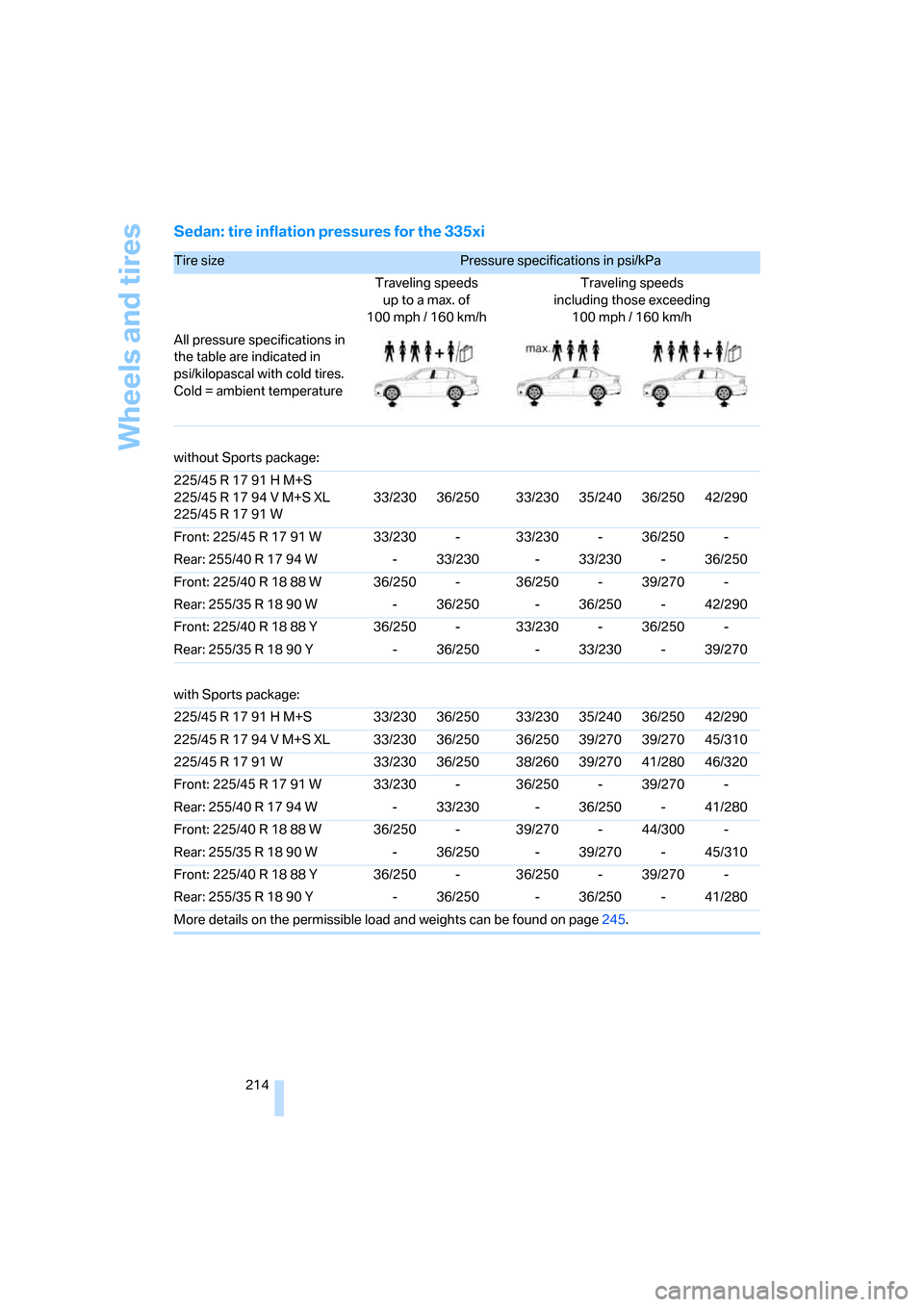
Wheels and tires
214
Sedan: tire inflation pressures for the 335xi
Tire size Pressure specifications in psi/kPa
Traveling speeds
up to a max. of
100mph / 160km/hTraveling speeds
including those exceeding
100 mph / 160 km/h
All pressure specifications in
the table are indicated in
psi/kilopascal with cold tires.
Cold = ambient temperature
without Sports package:
225/45 R 17 91 H M+S
225/45 R 17 94 V M+S XL
225/45 R 17 91 W33/230 36/250 33/230 35/240 36/250 42/290
Front: 225/45 R 17 91 W 33/230 - 33/230 - 36/250 -
Rear: 255/40 R 17 94 W - 33/230 - 33/230 - 36/250
Front: 225/40 R 18 88 W 36/250 - 36/250 - 39/270 -
Rear: 255/35 R 18 90 W - 36/250 - 36/250 - 42/290
Front: 225/40 R 18 88 Y 36/250 - 33/230 - 36/250 -
Rear: 255/35 R 18 90 Y - 36/250 - 33/230 - 39/270
with Sports package:
225/45 R 17 91 H M+S 33/230 36/250 33/230 35/240 36/250 42/290
225/45 R 17 94 V M+S XL 33/230 36/250 36/250 39/270 39/270 45/310
225/45 R 17 91 W 33/230 36/250 38/260 39/270 41/280 46/320
Front: 225/45 R 17 91 W 33/230 - 36/250 - 39/270 -
Rear: 255/40 R 17 94 W - 33/230 - 36/250 - 41/280
Front: 225/40 R 18 88 W 36/250 - 39/270 - 44/300 -
Rear: 255/35 R 18 90 W - 36/250 - 39/270 - 45/310
Front: 225/40 R 18 88 Y 36/250 - 36/250 - 39/270 -
Rear: 255/35 R 18 90 Y - 36/250 - 36/250 - 41/280
More details on the permissible load and weights can be found on page245.
Page 217 of 274
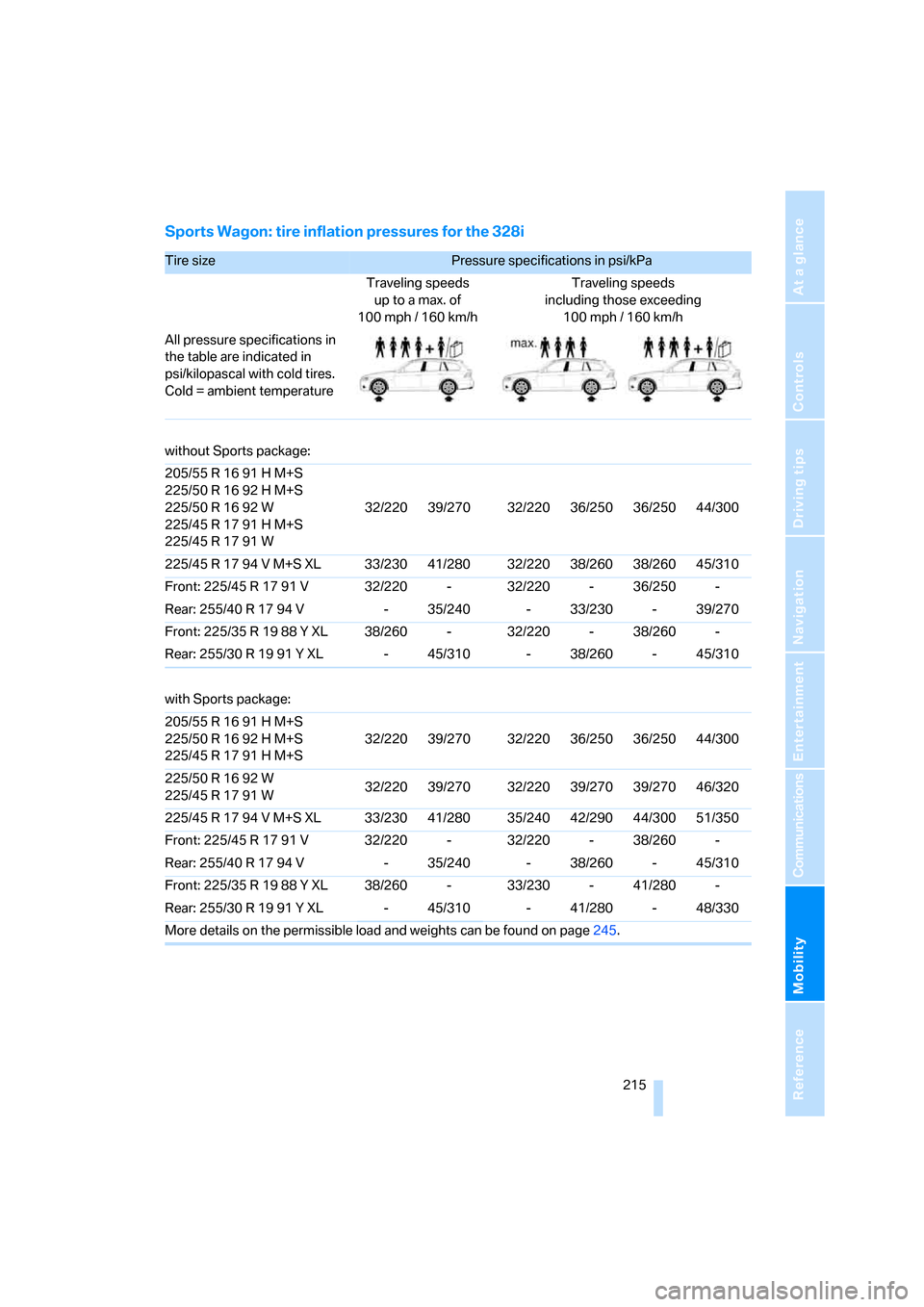
Mobility
215Reference
At a glance
Controls
Driving tips
Communications
Navigation
Entertainment
Sports Wagon: tire inflation pressures for the 328i
Tire size Pressure specifications in psi/kPa
Traveling speeds
up to a max. of
100 mph / 160 km/hTraveling speeds
including those exceeding
100mph / 160km/h
All pressure specifications in
the table are indicated in
psi/kilopascal with cold tires.
Cold = ambient temperature
without Sports package:
205/55 R 16 91 H M+S
225/50 R 16 92 H M+S
225/50 R 16 92 W
225/45 R 17 91 H M+S
225/45 R 17 91 W32/220 39/270 32/220 36/250 36/250 44/300
225/45 R 17 94 V M+S XL 33/230 41/280 32/220 38/260 38/260 45/310
Front: 225/45 R 17 91 V 32/220 - 32/220 - 36/250 -
Rear: 255/40 R 17 94 V - 35/240 - 33/230 - 39/270
Front: 225/35 R 19 88 Y XL 38/260 - 32/220 - 38/260 -
Rear: 255/30 R 19 91 Y XL - 45/310 - 38/260 - 45/310
with Sports package:
205/55 R 16 91 H M+S
225/50 R 16 92 H M+S
225/45 R 17 91 H M+S32/220 39/270 32/220 36/250 36/250 44/300
225/50 R 16 92 W
225/45 R 17 91 W32/220 39/270 32/220 39/270 39/270 46/320
225/45 R 17 94 V M+S XL 33/230 41/280 35/240 42/290 44/300 51/350
Front: 225/45 R 17 91 V 32/220 - 32/220 - 38/260 -
Rear: 255/40 R 17 94 V - 35/240 - 38/260 - 45/310
Front: 225/35 R 19 88 Y XL 38/260 - 33/230 - 41/280 -
Rear: 255/30 R 19 91 Y XL - 45/310 - 41/280 - 48/330
More details on the permissible load and weights can be found on page245.
Page 218 of 274

Wheels and tires
216
Sports Wagon: tire inflation pressures for the 328xi
Tire size Pressure specifications in psi/kPa
Traveling speeds
up to a max. of
100mph / 160km/hTraveling speeds
including those exceeding
100 mph / 160 km/h
All pressure specifications in
the table are indicated in
psi/kilopascal with cold tires.
Cold = ambient temperature
without Sports package:
205/55 R 16 91 H M+S
225/50 R 16 92 H M+S
225/50 R 16 92 W
225/45 R 17 91 H M+S
225/45 R 17 94 V M+S XL
225/45 R 17 91 W32/220 39/270 32/220 38/260 36/250 44/300
Front: 225/45 R 17 91 V 32/220 - 32/220 - 36/250 -
Rear: 255/40 R 17 94 V - 35/240 - 32/220 - 39/270
with Sports package:
205/55 R 16 91 H M+S
225/50 R 16 92 H M+S
225/45 R 17 91 H M+S32/220 39/270 32/220 38/260 36/250 44/300
225/50 R 16 92 W
225/45 R 17 91 W32/220 39/270 33/230 39/270 39/270 46/320
225/45 R 17 94 V M+S XL 32/220 39/270 35/240 42/290 42/290 49/340
Front: 225/45 R 17 91 V 32/220 - 33/230 - 38/260 -
Rear: 255/40 R 17 94 V - 35/240 - 36/250 - 44/300
More details on the permissible load and weights can be found on page245.
Page 220 of 274
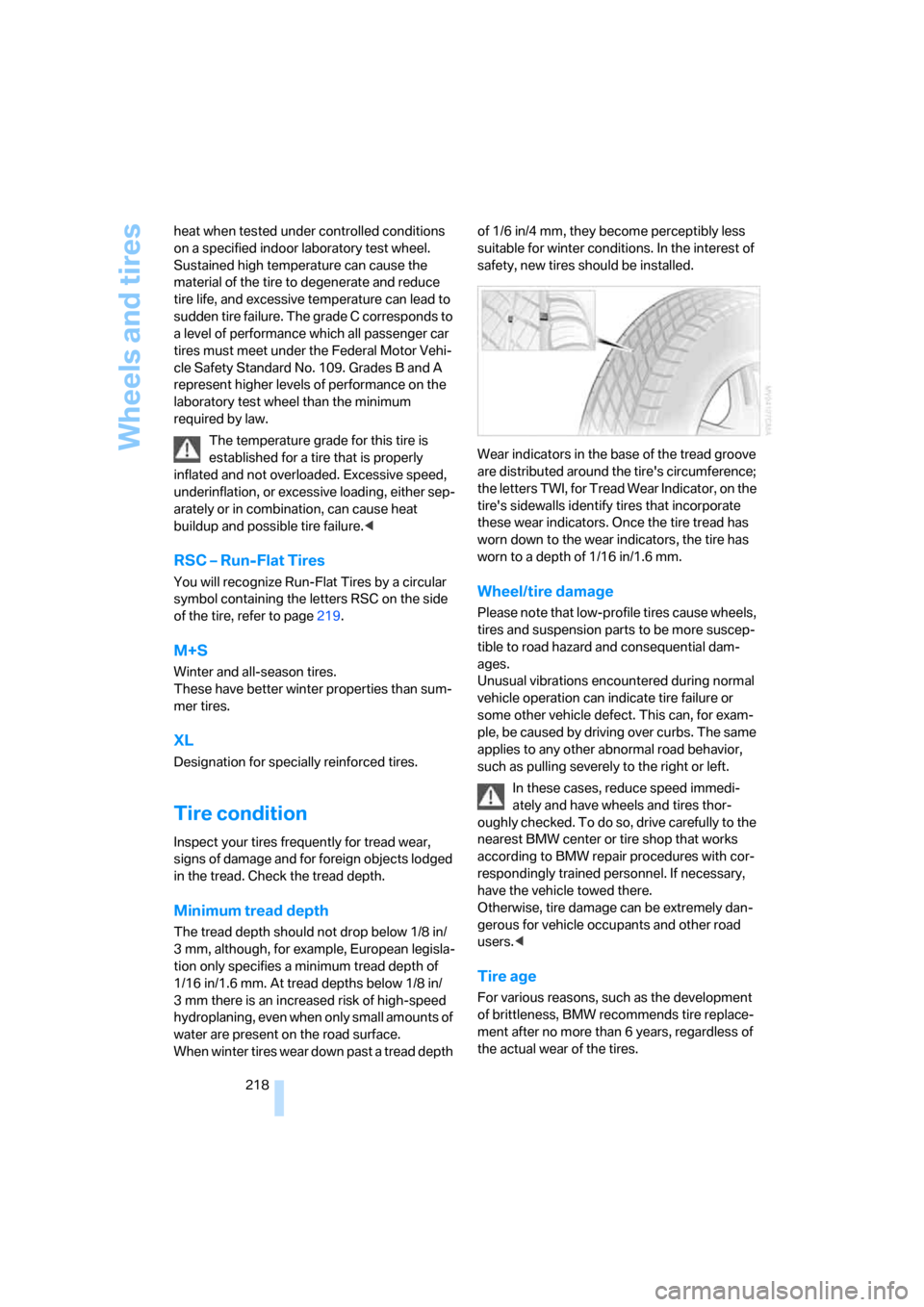
Wheels and tires
218 heat when tested under controlled conditions
on a specified indoor laboratory test wheel.
Sustained high temperature can cause the
material of the tire to degenerate and reduce
tire life, and excessive temperature can lead to
sudden tire failure. The grade C corresponds to
a level of performance which all passenger car
tires must meet under the Federal Motor Vehi-
cle Safety Standard No. 109. Grades B and A
represent higher levels of performance on the
laboratory test wheel than the minimum
required by law.
The temperature grade for this tire is
established for a tire that is properly
inflated and not overloaded. Excessive speed,
underinflation, or excessive loading, either sep-
arately or in combination, can cause heat
buildup and possible tire failure.<
RSC – Run-Flat Tires
You will recognize Run-Flat Tires by a circular
symbol containing the letters RSC on the side
of the tire, refer to page219.
M+S
Winter and all-season tires.
These have better winter properties than sum-
mer tires.
XL
Designation for specially reinforced tires.
Tire condition
Inspect your tires frequently for tread wear,
signs of damage and for foreign objects lodged
in the tread. Check the tread depth.
Minimum tread depth
The tread depth should not drop below 1/8 in/
3 mm, although, for example, European legisla-
tion only specifies a minimum tread depth of
1/16 in/1.6 mm. At tread depths below 1/8 in/
3 mm there is an increased risk of high-speed
hydroplaning, even when only small amounts of
water are present on the road surface.
When winter tires wear down past a tread depth of 1/6 in/4 mm, they become perceptibly less
suitable for winter conditions. In the interest of
safety, new tires should be installed.
Wear indicators in the base of the tread groove
are distributed around the tire's circumference;
the letters TWI, for Tread Wear Indicator, on the
tire's sidewalls identify tires that incorporate
these wear indicators. Once the tire tread has
worn down to the wear indicators, the tire has
worn to a depth of 1/16 in/1.6 mm.
Wheel/tire damage
Please note that low-profile tires cause wheels,
tires and suspension parts to be more suscep-
tible to road hazard and consequential dam-
ages.
Unusual vibrations encountered during normal
vehicle operation can indicate tire failure or
some other vehicle defect. This can, for exam-
ple, be caused by driving over curbs. The same
applies to any other abnormal road behavior,
such as pulling severely to the right or left.
In these cases, reduce speed immedi-
ately and have wheels and tires thor-
oughly checked. To do so, drive carefully to the
nearest BMW center or tire shop that works
according to BMW repair procedures with cor-
respondingly trained personnel. If necessary,
have the vehicle towed there.
Otherwise, tire damage can be extremely dan-
gerous for vehicle occupants and other road
users.<
Tire age
For various reasons, such as the development
of brittleness, BMW recommends tire replace-
ment after no more than 6 years, regardless of
the actual wear of the tires.
Page 221 of 274
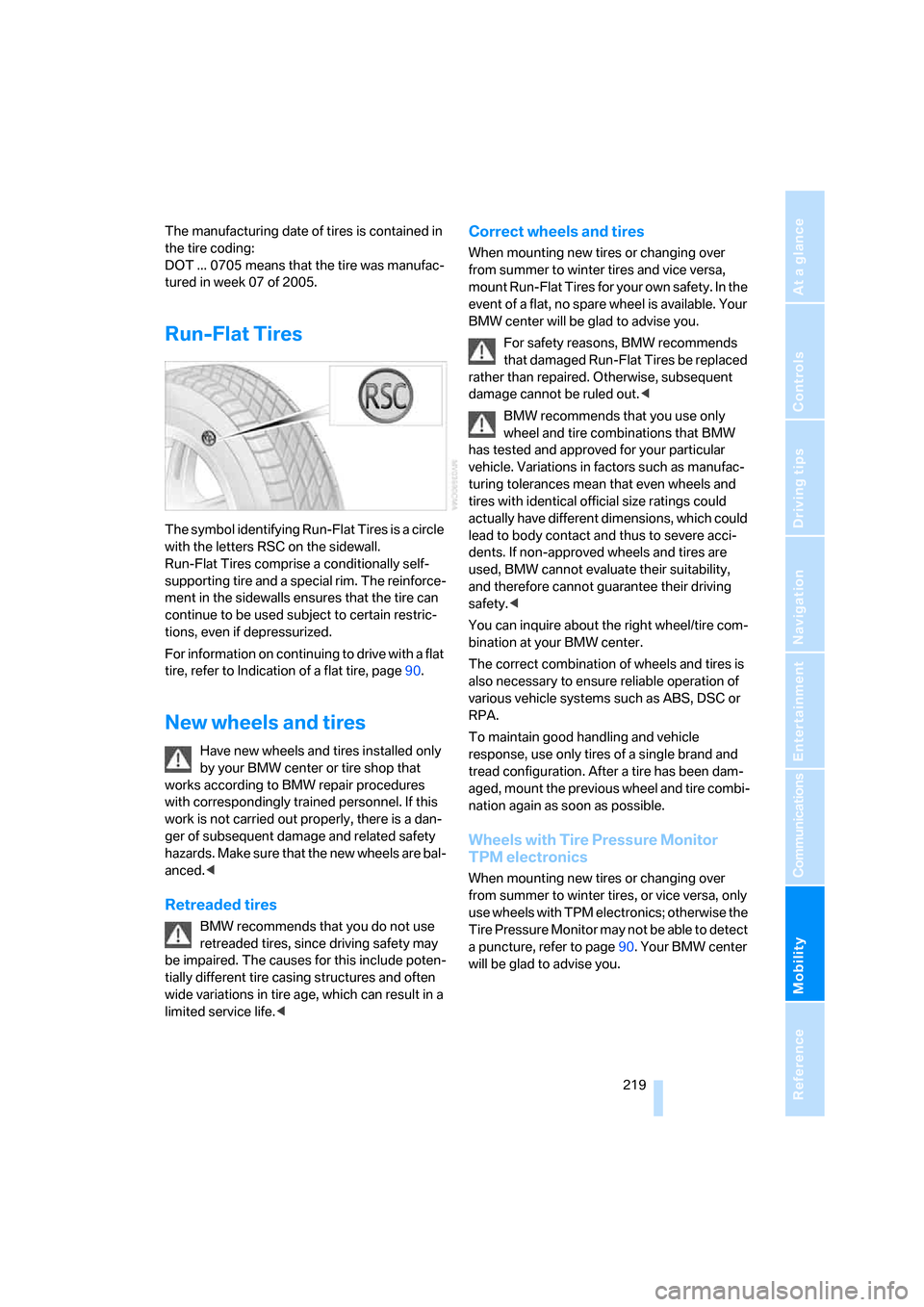
Mobility
219Reference
At a glance
Controls
Driving tips
Communications
Navigation
Entertainment
The manufacturing date of tires is contained in
the tire coding:
DOT ... 0705 means that the tire was manufac-
tured in week 07 of 2005.
Run-Flat Tires
The symbol identifying Run-Flat Tires is a circle
with the letters RSC on the sidewall.
Run-Flat Tires comprise a conditionally self-
supporting tire and a special rim. The reinforce-
ment in the sidewalls ensures that the tire can
continue to be used subject to certain restric-
tions, even if depressurized.
For information on continuing to drive with a flat
tire, refer to Indication of a flat tire, page90.
New wheels and tires
Have new wheels and tires installed only
by your BMW center or tire shop that
works according to BMW repair procedures
with correspondingly trained personnel. If this
work is not carried out properly, there is a dan-
ger of subsequent damage and related safety
hazards. Make sure that the new wheels are bal-
anced.<
Retreaded tires
BMW recommends that you do not use
retreaded tires, since driving safety may
be impaired. The causes for this include poten-
tially different tire casing structures and often
wide variations in tire age, which can result in a
limited service life.<
Correct wheels and tires
When mounting new tires or changing over
from summer to winter tires and vice versa,
mount Run-Flat Tires for your own safety. In the
event of a flat, no spare wheel is available. Your
BMW center will be glad to advise you.
For safety reasons, BMW recommends
that damaged Run-Flat Tires be replaced
rather than repaired. Otherwise, subsequent
damage cannot be ruled out.<
BMW recommends that you use only
wheel and tire combinations that BMW
has tested and approved for your particular
vehicle. Variations in factors such as manufac-
turing tolerances mean that even wheels and
tires with identical official size ratings could
actually have different dimensions, which could
lead to body contact and thus to severe acci-
dents. If non-approved wheels and tires are
used, BMW cannot evaluate their suitability,
and therefore cannot guarantee their driving
safety.<
You can inquire about the right wheel/tire com-
bination at your BMW center.
The correct combination of wheels and tires is
also necessary to ensure reliable operation of
various vehicle systems such as ABS, DSC or
RPA.
To maintain good handling and vehicle
response, use only tires of a single brand and
tread configuration. After a tire has been dam-
aged, mount the previous wheel and tire combi-
nation again as soon as possible.
Wheels with Tire Pressure Monitor
TPM electronics
When mounting new tires or changing over
from summer to winter tires, or vice versa, only
use wheels with TPM electronics; otherwise the
Tire Pressure Monitor may not be able to detect
a puncture, refer to page90. Your BMW center
will be glad to advise you.